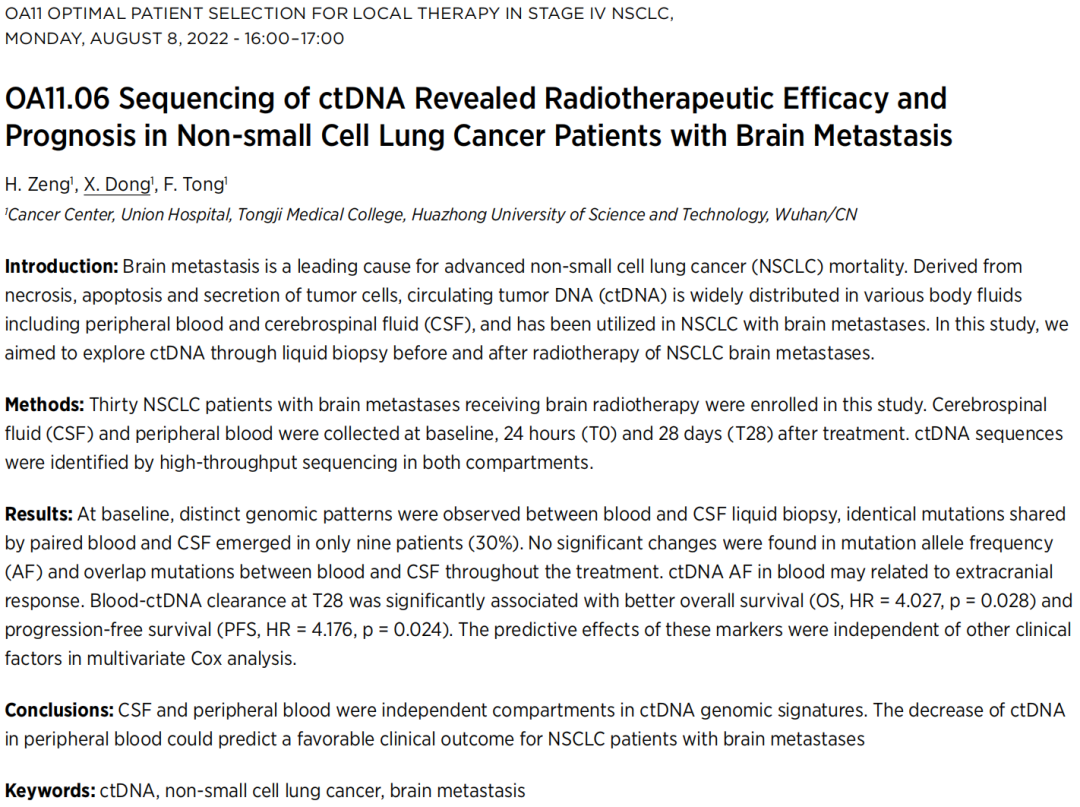The first -line immunotherapy+radiotherapy of lung cancer, the effect is better!| 2022 WCLC
Author:Cancer Channel of the Medical Time:2022.08.17
For medical professionals for reading reference

Professor Dong Xiaorong's two late NSCLC related research courier!
Lung cancer is the second in the world with the highest incidence and the highest mortality. In my country, the incidence and mortality rate of lung cancer ranks first in various tumors. Nearly 75%of patients in my country are in the first phase of the first diagnosis of lung cancer or a remote metastasis. One of the most common metastasis parts of lung cancer is the brain.
The prognosis of patients with lung cancer brain metastasis is poor, and the average survival time is only 1-2 months. Some patients with lung cancer recur after standardized treatment [2]. Exploring and evaluating the effectiveness of the treatment of lung cancer and the prognosis of biomarkers, and better treatment methods for the effect of clinicians have become the hotspot of clinicians.
Professor Dong Xiaorong has two studies selected for the 2022 World Ling Cancer Conference (WCLC), one of which is the circulatory tumor DNA (CTDNA) sequencing to reveal the effectiveness and prognosis of radiation treatment of lung cancer brain metastasis (Abstract: OA11.06), and the other is the front line PD-1 inhibitor and chemotherapy combined with or non-combined radiotherapy for advanced non-small cell lung cancer (NSCLC) (Abstract number: MA09.04), the two studies show biomarkers and biomarkers with good ability to predict the efficacy of lung cancer brain metastasis radiotherapy, respectively A joint treatment plan for the effect of late NSCLC.
Based on this, Professor Dong Xiaorong, the "Medical Circular Cancer Channel" invited Professor Dong Xiaorong, the Cancer Center of Tongji Medical College of Huazhong University of Science and Technology, shared the design, main results and clinical significance of the two related research.
First -line chemotherapy+immunomotive combined radiotherapy
Improved the ending of patients with late NSCLC
Professor Dong Xiaorong introduced: "Immunoma combined chemotherapy has become a standard first -line therapy plan for advanced NSCLC. Keynote189 Study [3] and Keynote407 Studies [4] all showed that the efficacy of immunotherapy for immunotherapy after immunotherapy in advanced NSCLC was significantly significantly. , But the data of the late NSCLC front -line immunotherapy combined radiotherapy has few data. The results of this research show that the addition of radiotherapy has brought obvious benefits to patients with advanced NSCLC. "

Figure 1.2022 WCLC Abstract MA09.04 [5]
Professor Dong Xiaorong published a study at this WCLC conference to innovate the efficacy and safety of patients with advanced NSCLC patients with advanced NSCLC patients who received first-line PD-1 inhibitors and chemotherapy combined or non-combined radiotherapy. Division of radiotherapy is divided into two groups. The radiotherapy parts include the radiotherapy of primary lesions and metastatic stoves. Radiotherapy technology includes strong radiotherapy (IMRT), 3D-CRT (3D-CRT), and three-dimensional directional radiation surgery (SRS, SBRT), etc. Essence The median interval between radiotherapy and immunochemistry is 5 days (0-96 days). The results of the study found that compared with the simple immunization group, the median PFS (16.5 VS 10.4 months, P = 0.043) and median OS (not reaching VS 21.0 months, P = 0.030) of the medium PFS (16.5 VS 10.4 months, P = 0.043) of the immunotherapy Benefiting, and single factors COX regression analysis shows that radiotherapy is the only prognosis factor [5].
Professor Dong Xiaorong added: "Although this research is a retrospective single center research, it continues to conduct multi -center research, and a large amount of data also supports the results of this research. And during the late NSCLC first -line treatment, standard treatment was in standard treatment. Based on the treatment of radiotherapy is also a relatively innovative treatment plan, which not only significantly improves the ending of the patient, but also shows acceptable toxic reactions. The only thing to pay attention to is whether the lungs will have superimposed reactions of immune pneumonia and radioactive pneumonia. In this research process, this situation is not observed, which may be related to a certain interval time between immunotherapy and radiation therapy. "
The blood CTDNA decreases after radiotherapy,
Patients with lung cancer brain metastasis better prognosis
Professor Dong Xiaorong introduced: "For the treatment of NSCLC brain metastasis, although there are many treatment methods, including local treatment surgery, radiotherapy, and targeted, immune, chemotherapy, etc. Space. So for patients with NSCLC brain metastasis, we conduct radiological treatment, including whole brain radiotherapy and local three -dimensional directional radiotherapy. In this process, monitor the changes in CTDNA of blood and cerebrospinal fluid to see if it can predict the efficacy and prognosis. " Figure 2.2022 WCLC Abstract OA11.06 [6] 该研究共入组了30例NSCLC脑转移患者,考虑到脑组织复杂的微环境,在治疗前两周内(基线)、脑部放疗之后24h内(T0)和脑部放疗后第28天( T28) Specifications for patients with blood and cerebrospinal fluids for patients with CTNDA and T cell antigen receptor (TCR) analysis. The analysis results found that during the baseline, different genome changes were observed in the liquid biopsy of blood and cerebrospinal fluid, and only 9 patients (30%) had the same gene mutation of blood and cerebrospinal fluid. At the same time, it was found in the liquid biopsy analysis of T0 and T28 that the genetic changes in blood and cerebrospinal fluid were not consistent, and the changes and correlations of tumor mutation load (TMB) and equal genetic frequency (AF) were low. In T28, the blood CTDNA was discovered, that is, the clearing rate of blood CTDNA, and better overall survival period (OS, HR = 4.027, P = 0.028) and no progressive survival (PFS, HR = 4.176, P = 0.024 ) [6] Significant correlation. These results show that blood and cerebrospinal fluid are the independent interval of the characteristics of CTDNA genome. The reduction of blood CTDNA can predict that patients with NSCLC brain metastasis will bring better clinical ending after radiotherapy. 董晓荣教授补充说:“在肺癌的放疗中,特别是NSCLC脑转移使用放疗中,以前没有太多相关的报道,所以这个研究对于指导临床治疗还是有一定的意义。另外,在这个研究中,我们At the same time, I also saw the changes in CTDNA in the cerebrospinal fluid. In fact, the effect of intracranial has a good correlation. We will continue to report in the future. " Research on late NSCLC will flourish Professor Dong Xiaorong concluded: "The detection of CTDNA has been used relatively widely. In the field of targeted therapy, the detection of CTDNA can be judged by CTDNA. There are many related reports that in the future, we will also report more data about CTDNA in the field of lung cancer treatment. At the same time, TCR analysis in liquid biopsy in this study has also been conducted. It was found that TCR and NSCLC brain metastasis treatment also had certain correlations, and we will conduct relevant reports in follow -up. In addition, it is not difficult to see in both studies that the addition of radiotherapy has improved the efficacy of patients and takes into account the good tolerance. Sexuality, when it is not the best, we must strive to be better, so that patients to use the treatment of non -increased toxic side effects on the basis of current treatment is the most important direction in the future. " Expert Introduction Dong Xiaorong Three -level professor, chief physician, doctoral supervisor Deputy director Director of the Department of chest and oncology at the Cancer Center of China University of Science and Technology Director of China Clinical Oncology Society Deputy Chairman of the China Pharmaceutical Education Association of the Lungs and Tumor Specialty Committee of the China Medical Education Association Standing Committee Member of the China Anti -Cancer Association Lung Cancer Expert Committee Standing Committee Member of the Chinese Clinical Oncology Society of Immunohistan Standing Committee Member of the China Clinical Oncology Society Standing Committee of the Education Expert Committee of the China Clinical Oncology Society Member of the China Clinical Oncology Society of Non -Cell Cancer Cancer Chairman of the Hubei Anti -Cancer Association Tumor Immunotherapy Committee Deputy Chairman of the Hubei Provincial Anti -Cancer Association Cancer Internal Medicine Special Committee references: [1] The Chinese Medical Doctors Association Oncologist Branch, China Medical Care International Exchange Promotion Association of the Cancer Department of Internal Medicine. Lung cancer brain metastasis China Treatment Guide (2021) [M]. [2] Wang Yiqing, Zhu Linhai, Lin Xu .CT guided by 125i particle implantation to the treatment of advanced lung cancer and lung metastatic cancer [J]. China Lung Cancer Magazine, June 2020, Volume 23, Issue 6. [3]Shirish Gadgeel,MB,BS;Delvys Rodr´ıguez-Abreu,MD;Giovanna Speranza,MD,MSc.Updated Analysis From KEYNOTE-189:Pembrolizumab or Placebo Plus Pemetrexed and Platinum for Previously Untreated Metastatic Nonsquamous Non–Small-Cell Lung Cancer.asco Journal of China Oncolgy 2020. Thoracic onCology Vol.15 No. 10: 1657–69. [5] P.ding, f.tong, x.dong.first-line PD-1 inhibitors and Chemotherapy or Without Radiotherapy InviantCancer.2022 WCLC MA09.04. [6] H.ZENG, X.Dong, F.tong.sequenCing of CTDNA Revealed Radiotherapeut Efficacy and Prognosis in Non-Small Cell LUNG CANCER PANCER PANCER PATH Brain Metastasis.2022 WCLC OA1111111111111111111111111111111111111111111111111111111111111's The first release of this article: the medical world tumor channel Author of this article: Deng Ying Editor in charge: Sweet - END -

China Release 丨 National Health and Health Commission: The effectiveness of the prevention and control of local epidemics is obviously that the national epidemic is generally at low level fluctuations

China Net June 28th On June 28, the State Council joint prevention and control mec...
How to accurately disinfect daily home
The new coronary virus is sensitive to ultraviolet and thermal sensitivity. Seat solvents such as ether, 75%ethanol, chlorine -containing disinfection agent, peroxylcetic acid, and chloroform can effe